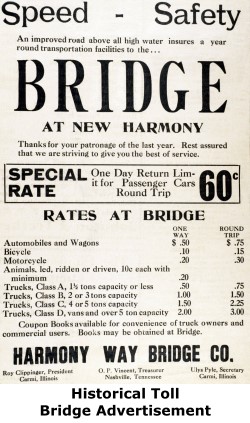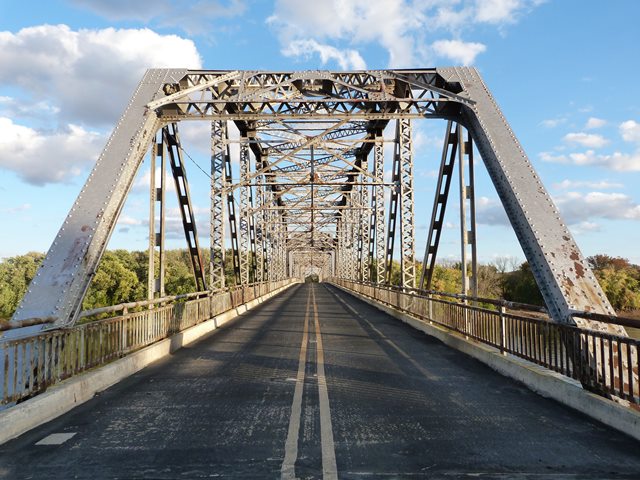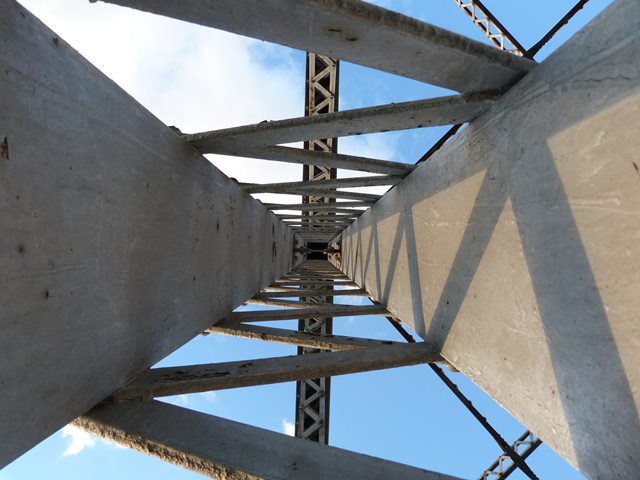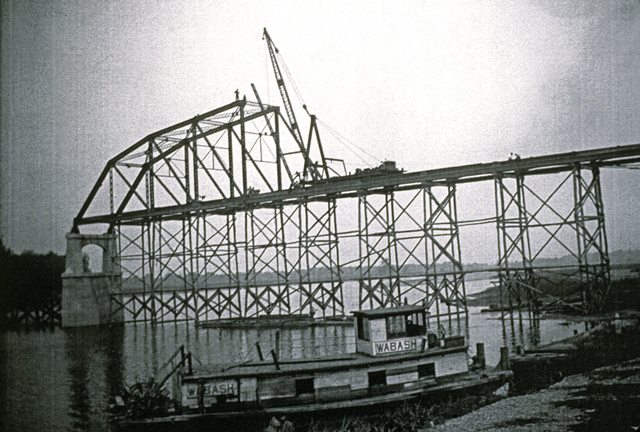We Recommend:
Bach Steel - Experts at historic truss bridge restoration.
New Harmony Bridge
Harmony Way Bridge
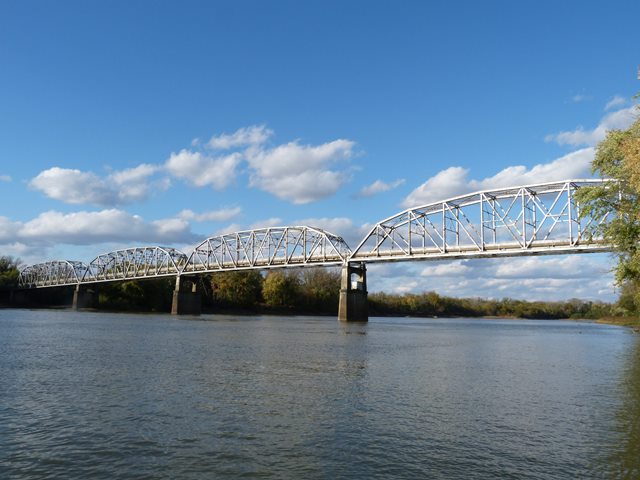
Primary Photographer(s): Nathan Holth
Bridge Documented: November 2, 2013
New Harmony: Posey County, Indiana and White County, Illinois: United States
Metal 10 Panel Rivet-Connected Parker Through Truss, Fixed and Approach Spans: Metal 7 Panel Rivet-Connected Warren Deck Truss, Fixed
1930 By Builder/Contractor: Nashville Bridge Company of Nashville, Tennessee
1962
300.0 Feet (91.4 Meters)
2,579.0 Feet (786.1 Meters)
20 Feet (6.1 Meters)
4 Main Span(s) and 34 Approach Span(s)
23305

View Information About HSR Ratings
Bridge Documentation
This bridge's future is at risk!
Bridge Status: This historic bridge is at risk for demolition!View Archived National Bridge Inventory Report - Has Additional Details and Evaluation
View The National Register of Historic Places Nomination Form For This Historic Bridge
View Selected Original Plan Sheets For This Historic Bridge
View A Timeline For This Bridge
View A Historical Dedication Pamphlet
Note: Special thanks are due to Dr. James L. Cooper for his extensive research on this bridge the results of which were kindly made available to HistoricBridges.org. Most of the information, history, and materials relating to this bridge are thanks to his research efforts. Be sure to view the National Register Nomination Form for this bridge, linked above, for a detailed discussion of the bridge.
This bridge is a large bridge that includes a variety of span types. The long approach system at each end consists of steel stringer spans supported by steel bents. There are also two deck truss approach spans, one of 60 foot and one of 100 feet at the eastern approach. The main spans of the bridge are four rivet-connected Parker through truss spans. The western three Parker truss spans range from 232-234 feet in length, while the eastern Parker truss span is quite a bit longer with its 300 foot span. The bridge is a state line bridge. In the context of Indiana, the Parker truss spans are the largest of their kind in the state.
The bridge has an uncommon ownership history, as it was built under the direction of the Harmony Way Bridge Company. Ownership and operation of a bridge by a bridge company was common for large bridges in the 1800s, but was much less common by the time this bridge was built. Even more unusual, the bridge continued to be operated as a toll bridge, later taken over by a bridge commission. Toll bridges in the present day are usually associated with enormous bridges or bridges on busy freeways. A toll bridge for a small town carrying a two-lane road is somewhat uncommon.
The truss spans of this bridge enjoy excellent historic integrity with no major alterations. Many of the approach stringer spans are also unaltered. However, a number of the approach spans were replaced by the Army Corps of Engineers with cantilevered steel stringer spans and new concrete piers with the intent of addressing problems with the river and original bents near the river.
In 2012, the bridge was closed when an inspection report noted significant deterioration. It is worth noting that the original bridge material is in general in fair condition. The highly deteriorated sections of the bridge are the non-original spans put in by the Army Corps.
The future of this bridge is uncertain. Many locals are supportive of restoring and reopening the bridge, however demolition of the bridge is on the table for consideration as well.
HistoricBridges.org is proud to feature an extremely extensive photo-documentation of this bridge. As the bridge was closed to traffic, it allowed for an unusually extensive ease of access to get photos from every angle.
Information and Findings From DHPA Historic Bridge SurveyStatement of Significance A number of features make this structure noteworthy. The crossing is long-standing, the toll feature atypical for Indiana, and the fabricator unusual here. The design also has some special features. The pattern for sloping the Parkers' top chords and the counterbalancing-struts of the center panels are quite unusual. Deck trusses are not common in Indiana either, and again the counter diagonals of the center panel in the longest Warren is different. The bridge appears to retain all its original members, including guardrails. Architectural Description To replace the traditional ferry crossing of the Wabash River at New Harmony, Indiana, the Harmony Way Bridge Company proposed the construction of a toll bridge probably in the early 1920s when a considerable
number of toll structures for across the Ohio and Wabash were being discussed in river communities. By March 1929 Congress had granted a franchise for the Harmony Way Bridge, the War Department approved plans, and construction was
scheduled for summer 1930. The Nashville Bridge Company of Nashville, Tennessee, fabricated the steel spans, metal piers, and pier towers or bents for the 2,579-ft. structure. By September 1939, the Harmony Way Bridge Company
offered to sell their bridge to the state of Indiana, and within a year the Indiana State Toll Bridge Commission had agreed to purchase the structure for $945,000. Apparently the agreement with the state of Indiana was never
completed, since the White County Illinois Bridge Commission now owns and maintains the structure. Bridge Considered Historic By Survey: Yes |
![]()
Photo Galleries and Videos: New Harmony Bridge
Structure Overview
Original / Full Size PhotosA collection of overview photos that show the bridge as a whole and general areas of the bridge. This gallery offers photos in the highest available resolution and file size in a touch-friendly popup viewer.
Alternatively, Browse Without Using Viewer
![]()
Structure Details
Original / Full Size PhotosA collection of detail photos that document the parts, construction, and condition of the bridge. This gallery offers photos in the highest available resolution and file size in a touch-friendly popup viewer.
Alternatively, Browse Without Using Viewer
![]()
Structure Overview
Mobile Optimized PhotosA collection of overview photos that show the bridge as a whole and general areas of the bridge. This gallery features data-friendly, fast-loading photos in a touch-friendly popup viewer.
Alternatively, Browse Without Using Viewer
![]()
Structure Details
Mobile Optimized PhotosA collection of detail photos that document the parts, construction, and condition of the bridge. This gallery features data-friendly, fast-loading photos in a touch-friendly popup viewer.
Alternatively, Browse Without Using Viewer
![]()
Historical Photos
Original / Full Size PhotosA collection of historical photos including photos showing the construction of the bridge. This gallery offers photos in the highest available resolution and file size in a touch-friendly popup viewer.
Alternatively, Browse Without Using Viewer
![]()
Historical Photos
Mobile Optimized PhotosA collection of historical photos including photos showing the construction of the bridge. This gallery features data-friendly, fast-loading photos in a touch-friendly popup viewer.
Alternatively, Browse Without Using Viewer
![]()
Bridge Documentary
Full Motion VideoProduced by Dave Black, assistant professor of communications, this one-hour documentary traces the construction of the bridge, changes in its government oversight, and the recent efforts led by former USI President David L. Rice to find a long-term solution for its survival. The video features interviews with bridge experts, political leaders, and area residents discussing the governance of the bridge and its importance to the southern regions of Indiana and Illinois. The program is narrated by Wayne Rinks, chair of the Department of Communications, and Pam Moore, senior administrative assistant in the College of Liberal Arts. Streaming video of the bridge. Also includes a higher quality downloadable video for greater clarity or offline viewing.
![]()
Maps and Links: New Harmony Bridge
Coordinates (Latitude, Longitude):
Search For Additional Bridge Listings:
Bridgehunter.com: View listed bridges within 0.5 miles (0.8 kilometers) of this bridge.
Bridgehunter.com: View listed bridges within 10 miles (16 kilometers) of this bridge.
Additional Maps:
Google Streetview (If Available)
GeoHack (Additional Links and Coordinates)
Apple Maps (Via DuckDuckGo Search)
Apple Maps (Apple devices only)
Android: Open Location In Your Map or GPS App
Flickr Gallery (Find Nearby Photos)
Wikimedia Commons (Find Nearby Photos)
Directions Via Sygic For Android
Directions Via Sygic For iOS and Android Dolphin Browser
USGS National Map (United States Only)
Historical USGS Topo Maps (United States Only)
Historic Aerials (United States Only)
CalTopo Maps (United States Only)




